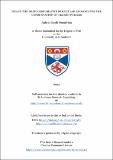DNA in the deep : comparative molecular ecology for the conservation of beaked whales
Abstract
Beaked whales (Ziphiidae) are an incredibly diverse and elusive family, and behavioural responses linked to certain anthropogenic sounds have resulted in mass stranding events. The substantial knowledge gaps regarding abundance and population structure for most ziphiids highlight that more information is required for their effective management and conservation. To this end, next-generation DNA sequencing was used to investigate beaked whale ecology and evolution, showcasing the utility of reduced representation sequencing in non-model organisms. Single nucleotide polymorphisms (SNPs) were derived using double-digest restriction site associated DNA sequencing (ddRAD) from a newly established international beaked whale tissue and DNA archive.
Globally, hierarchical genetic structure and diversity of cosmopolitan Cuvier’s and Blainville’s beaked whales (Ziphius cavirostris and Mesoplodon densirostris, “Cuvier’s” and “Blainville’s”) were investigated. Biogeographic barriers and differing life and evolutionary histories have contributed to the observed patterns, and the findings are evaluated in the context of management units for conservation. Regionally, population structure and demographic history were characterised for four North Atlantic beaked whales: Cuvier’s, Blainville’s, Sowerby’s beaked whales (M. bidens) and northern bottlenose whales (Hyperoodon ampullatus). Fluctuations in effective population size (Ne) were likely responses to climatic change. With these findings, potential responses of beaked whale populations to future climate change are discussed. Locally, genetic Essential Biodiversity Variables (EBVs) were calculated for paired ‘disturbed’ and ‘semi-pristine’ populations of Cuvier’s and Blainville’s in three well studied populations: the Bahamas, Canary Islands and Mediterranean Sea (Cuvier’s only). At least one ‘disturbed’ site was found in each region with reduced genetic variation and at risk of genetic erosion.
In summary, genetic population structure has been identified in many ziphiids. These populations have different levels of genetic diversity, different demographic responses to historic climatic change and it is likely that they have different abilities to adapt to future anthropogenic and climate impacts and should be managed on a population level.
Type
Thesis, PhD Doctor of Philosophy
Rights
Creative Commons Attribution-NonCommercial-NoDerivatives 4.0 International
http://creativecommons.org/licenses/by-nc-nd/4.0/
Collections
Description of related resources
DNA in the deep: Comparative molecular ecology for the conservation of beaked whales (thesis data) Onoufriou, A., University of St Andrews, 25 April 2023. DOI: https://doi.org/10.17630/411968f3-6191-4789-8316-90fa2c3473c4Related resources
https://doi.org/10.17630/411968f3-6191-4789-8316-90fa2c3473c4
Except where otherwise noted within the work, this item's licence for re-use is described as Creative Commons Attribution-NonCommercial-NoDerivatives 4.0 International
Items in the St Andrews Research Repository are protected by copyright, with all rights reserved, unless otherwise indicated.


